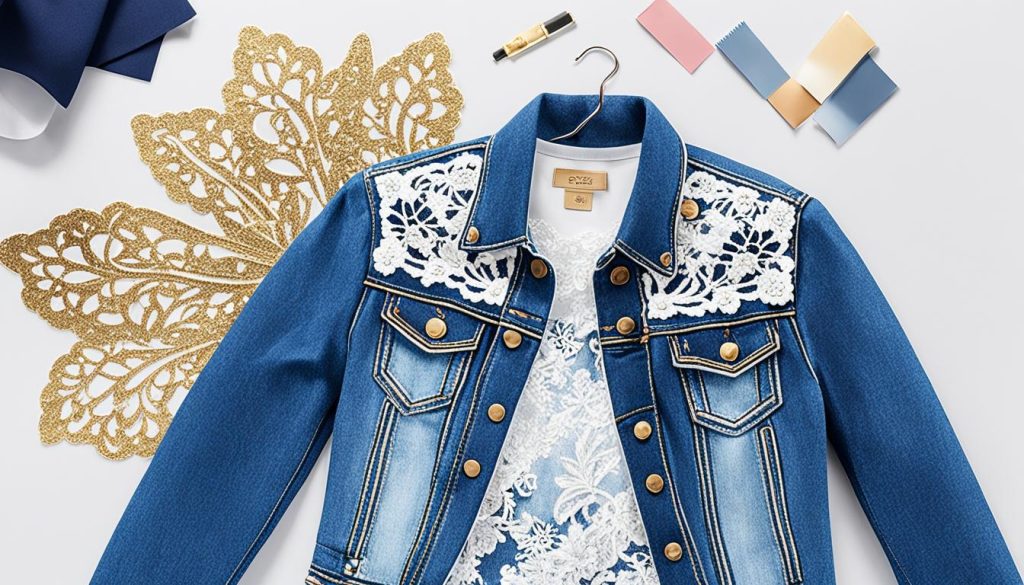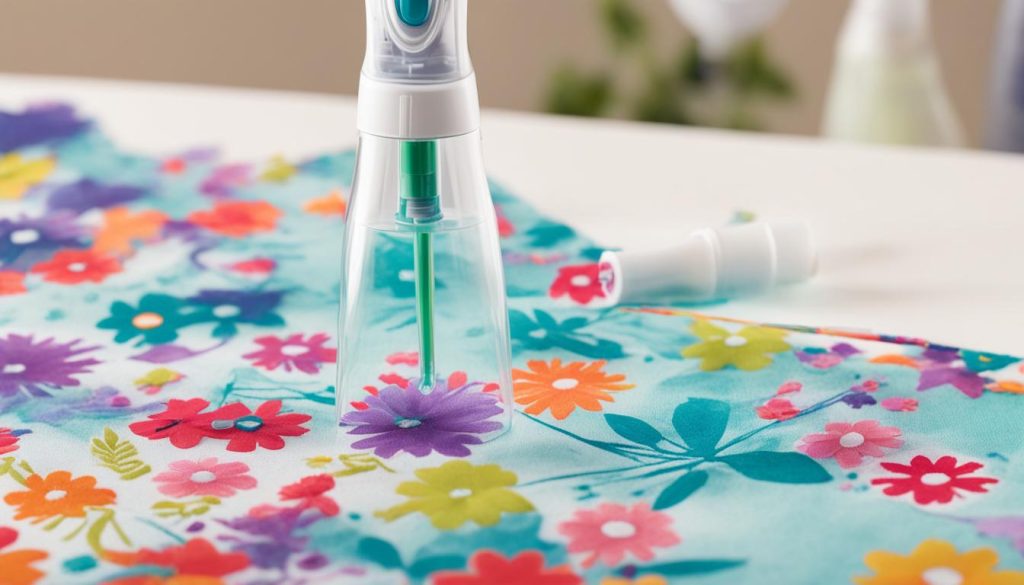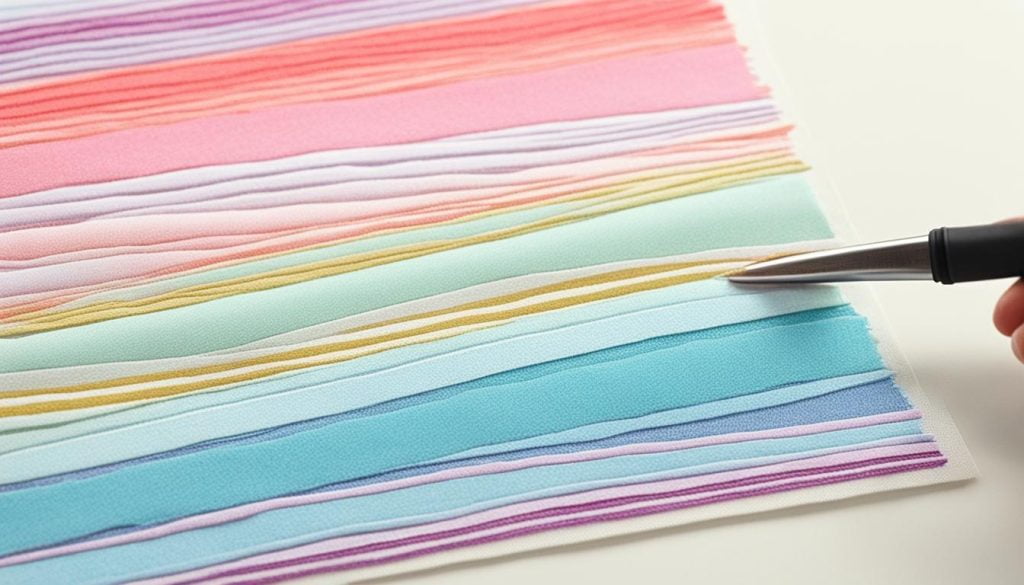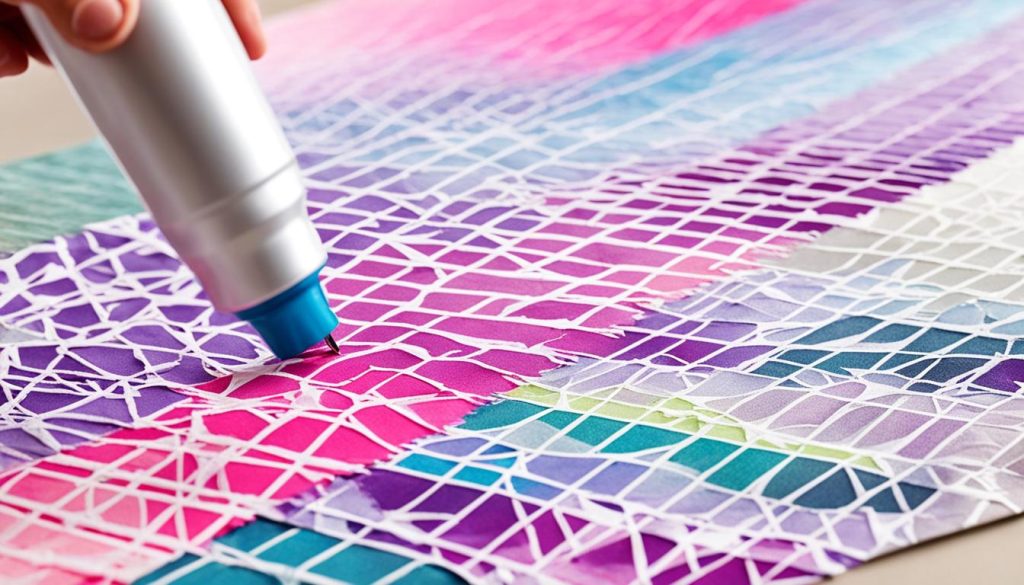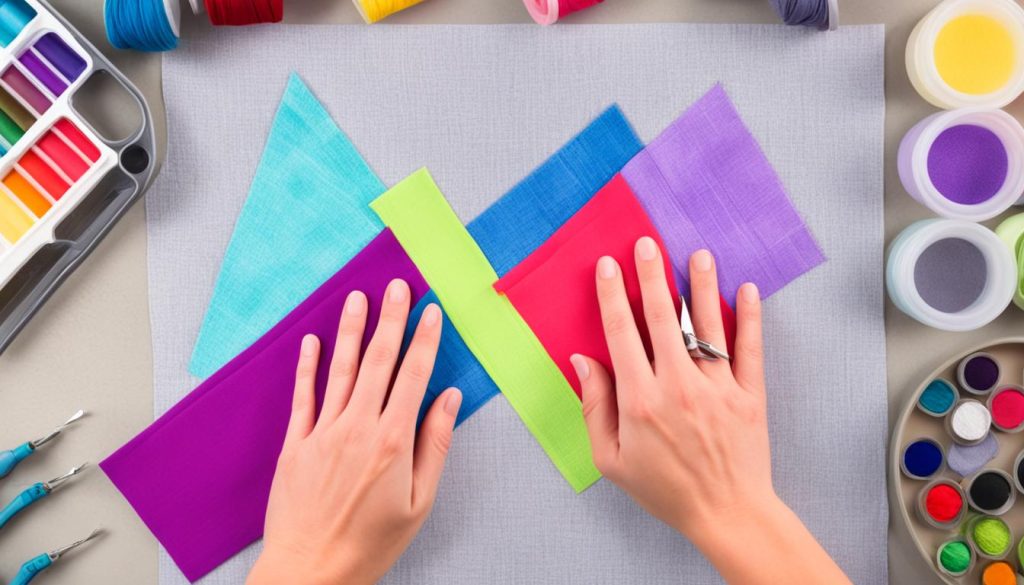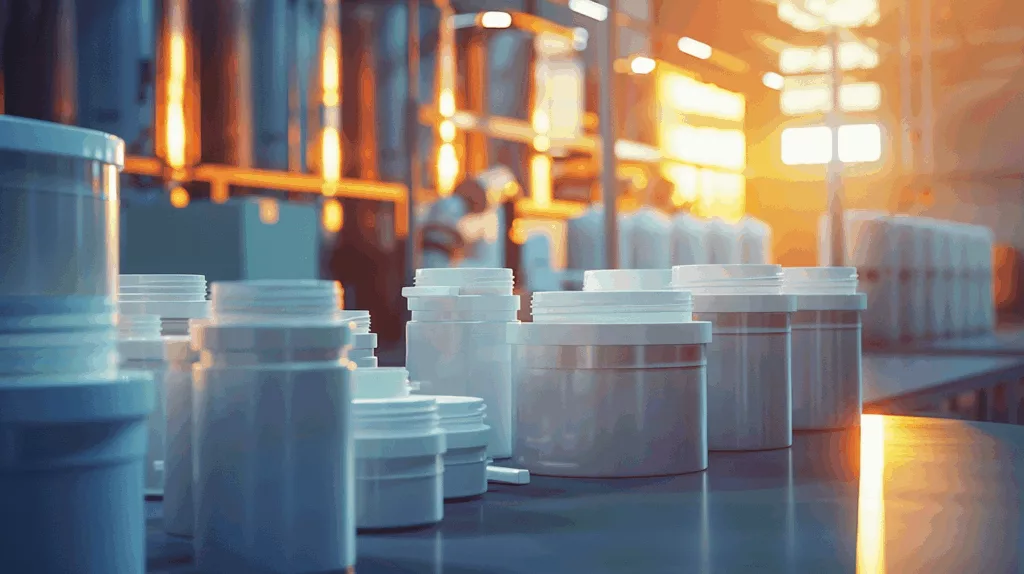Exploring the world of fabric adhesives is an exciting journey. It’s for DIY fans and professional crafters alike. If you’re into sewing, making costumes, or adding details to fabrics, you need the right fabric adhesive. Finding the perfect textile adhesive is key for top-notch results. We’ll explore the best adhesives for different materials and uses here.
Choosing the ideal adhesive for sewing projects is crucial for durability and ease. It paves the way for successful crafting. Join us as we reveal how to pick the best fabric adhesive for your projects. This will take your creative work to new heights.
Key Takeaways
- An introduction to various fabric adhesives available for crafters.
- Importance of selecting the appropriate adhesive for different fabrics.
- Focus on ensuring project longevity and ease of use.
- Target audience includes both hobbyists and professional crafters in the U.S.
- Insight into the most effective products for fabric projects.
Understanding Fabric Adhesives
Exploring fabric adhesives simplifies textile projects. It skips sewing, saves time, and gives a neat finish. It’s great for both newbies and experts.
What is Fabric Adhesive?
Fabric glue, or fabric adhesive, is a special bonding solution for textiles. It’s safe for delicate fabrics and flexibly bonds. Great for both temporary and permanent fixes.
Types of Fabric Adhesives
Different fabric adhesives suit different projects:
- Permanent Adhesives: Best for lasting bonds like hemming or adding patches.
- Temporary Adhesives: Great for adjustable projects, such as quilt basting.
- Fusible Adhesives: Heat activates these for strong bondings, ideal for appliqués.
- Non-Fusible Adhesives: Use these where ironing won’t work.
Benefits of Using Fabric Adhesive in Crafts
Using fabric glue has big pluses for crafting. It bonds precisely without stitching, saving effort. It’s great for detailed works that sewing machines can miss. Also, it often leaves a tidy, unseen finish. So, for both quick fixes or lasting projects, it’s incredibly handy.
Top Fabric Adhesives on the Market
Looking for the best fabric adhesives can be a challenge. Crafters want products that perform well and offer flexibility. ZDS™ has become a top choice for both hobbyists and experts. Let’s explore why ZDS™ Premium Fabric Adhesive is a favorite.
ZDS™ Premium Fabric Adhesive
ZDS™ Premium Fabric Adhesive is known for its strong bond. It’s the top choice for fabric-to-fabric gluing. This glue works on many textiles, giving a solid and lasting connection. Experts and users alike have highly rated ZDS™ for its dependability and quality.
Applying ZDS™ is easy for any project size. It helps make any sewing or textile art project simpler. ZDS™ Premium Fabric Adhesive makes crafting smoother for everyone.
ZDS™ Premium Fabric Adhesive is the best for several reasons:
- Strong Bond: It gives a secure and enduring grip on various fabrics.
- Versatility: It’s great for cotton, polyester, and silk alike.
- Ease of Use: The glue is simple to apply and dries quickly.
- User Experiences: Both DIY fans and professionals have praised it.
ZDS™ Premium Fabric Adhesive also makes crafting easier, saving time and effort. See this table for a quick look at its advantages:
| Feature | Description |
|---|---|
| Bond Strength | Excellent adhesion across various textiles |
| Drying Time | Fast-drying for quick project turnaround |
| Application | Easy to apply with minimal wastage |
| Versatility | Compatible with multiple fabric types |
| User Feedback | Rated highly for reliability and performance |
Choosing the Best Fabric Adhesive for Your Projects
Picking the right fabric adhesive is key for your projects. It’s vital to look at many factors. This ensures your work lasts long and performs well.
Factors to Consider
First, make sure the adhesive fits the fabric. Each fabric type needs a specific glue for a good bond.
Next, think about how strong the adhesive should be. Heavy use or washable items need stronger glue than indoor decor.
Also, think about the environment. For outdoor or wet items, use waterproof glue. There’s a different best choice for each project.
Comparing Fabric Adhesives by Use Case
Choosing the right glue gets easier when you compare them. Here’s a table to guide you:
| Adhesive Type | Best For | Key Characteristics |
|---|---|---|
| Permanent Adhesive | Heavy-duty projects, upholstery | High strength, long-lasting |
| Temporary Adhesive | Basting quilts, applique | Repositionable, easy to remove |
| Spray Adhesive | Large surface applications | Even coverage, quick drying |
| Waterproof Adhesive | Outdoor projects, swimwear | Moisture-resistant, flexible |
This guide aims to help you find the best spray adhesive for fabric and others for sewing. The right glue improves your crafted items’ quality and durability.
How to Use Fabric Adhesive: Step-by-Step Guide
Learning how to apply fabric adhesive can really improve your projects. This guide will show you how to get perfect results every time.
Preparation
First, prepare your materials. Pick the right adhesive for your project, like spray, brush-on, or roll-on. Make sure the surfaces to stick together are clean and dry.
- Get ready with a clean area, gloves, and good air flow for spray adhesives.
- Try the glue on a small piece of fabric to see if it works well.
- Mark where to put the glue to use just the right amount.
Application Techniques
Let’s look at some ways to use fabric glues effectively:
- Spray Adhesives: Spray evenly from the right distance to avoid lumps.
- Brush-On Adhesives: Use steady, smooth strokes to cover the whole area.
- Roll-On Adhesives: Perfect for big areas. Apply evenly and press the fabrics together well.
Tips for Best Results
For the best bonding, follow these tips:
These smart moves help you get the strongest hold:
- Let the glue dry as long as the instructions say for a solid bond.
- For some glues, use a cloth and heat to make the bond stronger.
- Keep your glues stored right so they work great next time.
Stick to these steps and advice to make your fabric crafts look and last better.
Spray Adhesive for Fabric: Pros and Cons
Spray adhesive for fabric is popular among crafters. It’s easy to use and effective. Let’s look at its benefits and drawbacks.
Advantages of Spray Adhesives
Spray adhesives provide enhanced stability. This is key for professional-looking embroidery. It’s great for both beginners and experts. Spray adhesive also cuts down the time to finish a project. It lets you stitch faster on big or complex designs.
The versatility of spray adhesive stands out too. It works for various embroidery projects. This includes machine and hand embroidery on fabrics like cotton and silk. Even with a strong hold, it’s easy to remove by washing, leaving no residue.
Drawbacks to Consider
There are downsides to spray adhesive. One problem is possible residue build-up if not used or cleaned right. This can mess up your project’s final look. Also, the cost can add up, making it hard for budget crafters. You’ll need to buy more often because you can’t reuse it much.
Not all fabrics work well with spray adhesives. It’s best to test it on a small part first. Make sure you’re in a well-ventilated area to avoid fume issues. Using it right is a key consideration for good results.
Fabric Glue vs. Traditional Sewing
Choosing between fabric glue and traditional sewing changes how strong and lasting your craft is. Both have their good points and downsides. By looking at these, we know which is better for different crafts.
Comparison of Strength and Durability
Fabric glue and sewing both affect how tough and lasting a bond is. Fabric glue creates a solid, permanent bond good for everyday use and washes. But, sewing can be stronger in areas that get a lot of wear, like seams and edges.
Here’s their performance:
| Aspect | Fabric Glue | Traditional Sewing |
|---|---|---|
| Bond Strength | Strong, but may vary with adhesive quality | Generally stronger in high-stress areas |
| Durability | Durable, especially with quality glues | Highly durable, especially with dense stitching |
Efficiency and Time-Saving Aspects
When making crafts, how quick and easy a method is matters a lot. Fabric glue is fast and easy, perfect for when you’re in a hurry or don’t like to sew. It’s quicker than setting up to sew, especially for small, detailed items.
Here’s a quick comparison:
- Fabric Glue: Quick to apply, dries fast, no special tools needed
- Traditional Sewing: Needs setup, like threading, takes more time, but is precise
Fabric glue is great for those who value quickness and ease. Sewing is best for when you need strength and lasting power.
Tips for Maintaining Projects Bonded with Adhesive
To make sure your adhesive-bonded fabric projects last longer, clean and handle them carefully. Doing this helps keep the adhesive strong and your fabric looking new.
Cleaning and Care Instructions
For cleaning adhesive bonded projects, using a mix of isopropyl alcohol and water works well. This mix is good for cleaning surfaces before you bond them. If you’re working with wood or concrete, seal them first to improve the bond strength.
Before applying adhesive, roughening the surface can really help. This increases the area the adhesive can stick to, making a stronger bond. Protect metals like copper and brass with a coat of lacquer to prevent rust and keep the bond strong.
Handling Wear and Tear
Proper maintenance is key for adhesive-bonded fabric projects facing wear and tear. Use a primer on tricky surfaces to help the adhesive stick better. For materials like glass or stone, special additives can make the adhesive bond stronger.
Materials like PVC may need special attention to stop components from moving around. The same goes for rubber materials, which require a primer for a durable bond. Remember, carefully preparing surfaces can make a big difference in how well adhesives work.
For a step-by-step guide on preparing surfaces for adhesive, check out this comprehensive guide.
| Material | Preparation Method |
|---|---|
| Wood/Concrete | Sealing with paint, varnish, or epoxies |
| Siliceous Materials | Silane coupling agents |
| Copper/Brass/Bronze | Coating with lacquer or varnish |
| PVC/Vinyl | Using blocking products |
| Rubber (Neoprene/EPDM) | Applying primers |
Common Mistakes to Avoid When Using Fabric Adhesive
Using fabric adhesive can really change the game for your textile projects. But, it’s crucial to know about common mistakes that could mess up your results. We’ll go over some key errors and how to dodge them. This ensures your adhesive application is on point and your projects turn out amazing.
Overuse or Underuse of Adhesive
Getting the amount of fabric adhesive right is vital. Using too much can create a sticky mess and long drying times. Meanwhile, too little leads to weak bonds that don’t last. Always check the manufacturer’s instructions to learn the correct amount needed.
Ignoring Drying Times
Skipping the recommended drying times can weaken the bond. It’s important to wait and let the fabric adhesive set and cure as advised. Rushing can cause bonds to form incompletely. This affects the durability of your projects.
Not Preparing Surfaces Properly
For a strong adhesive bond, surface prep is key. Make sure surfaces are clean, dry, and free from dust or oils. If your fabrics need it, pre-wash them and remove any residues. Skipping this step can lead to a weak bond and project failure.
Conclusion
As we end our journey through the world of fabric adhesives, choosing the right one is key. We’ve looked at different types, their benefits, and how they’re used. Every crafter needs to know this to make smart choices.
With so many adhesives out there, it might seem hard to choose. But this guide should have helped you understand your options. Whether you’re working on a complex project or a simple fix, picking the right glue matters. It makes your creation last longer and look better. For example, ZDS™ Premium Fabric Adhesive stands out for its quality and flexibility.
Combining your artistic drive with smart choices leads to great crafting. We’ve shared many tips and product suggestions here. We hope they inspire you to take on new projects with confidence. Keep pushing your creative limits and finish projects proudly. Enjoy your crafting!
FAQ
What is fabric adhesive?
It’s a special glue for textiles. It sticks fabrics together without sewing.
What types of fabric adhesives are available?
We have many kinds, like permanent and temporary. There are also fusible and non-fusible options.
How do I choose the best fabric adhesive for my project?
Think about what fabrics you’re using and the bond you need. Spray adhesives work well for big areas.
Permanent glues are good for clothes that must last.
What are the benefits of using fabric adhesive?
They create strong bonds and make detailing easy without sewing. They’re simple to apply too.
How do I use fabric adhesive?
Start by getting your fabric ready. Apply glue as the maker recommends. Let it dry well.
Always follow the product’s instructions for the best outcome.
Can fabric adhesive be washed?
Yes, many can be washed. Just be sure to check the care instructions to keep the bond strong.
What are the pros and cons of spray adhesive for fabric?
Pros are it’s quick to apply and dries fast. But, you might get overspray. You need good air flow when using it.
And you must be careful to apply it neatly.
Can fabric glue replace sewing entirely?
Yes, fabric glue works well for lots of tasks. It’s strong and easy to use. Yet, sewing might still be best for highly durable needs.
How do I maintain projects that are bonded with adhesive?
Look after them based on the glue’s care instructions. Gentle washes and careful use keep them in good shape.
What are common mistakes to avoid when using fabric adhesive?
Don’t use too much or too little. Give it time to dry. Make sure surfaces are ready.
Right application and sticking to the guidelines help avoid problems.


